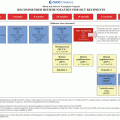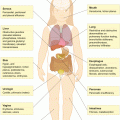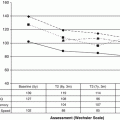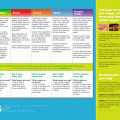Fig. 26.1
Medical and psychosocial risk factors for negative psychosocial outcomes among childhood cancer survivors
Our understanding of the impact of cognitive late effects on childhood cancer survivors is informed by studies regarding survivors’: (1) psychological quality of life; (2) educational indicators such as the need for special education, academic achievement, high school graduation, and college entrance; and (3) realization of experiences related to life satisfaction such as career development and marriage. Studies to date consistently show the link between CNS treatment and cognitive late effects, with more intensive treatments, younger age at diagnosis, and female gender predicting greater impairment. Importantly, cognitive late effects are associated with the need for regular neuropsychological assessment and specialized educational and cognitive interventions that promote academic achievement and social development. When childhood cancer survivors are able to receive and benefit from these interventions, their future outlook becomes brighter. Emotionally, experiencing purpose in one’s life as well as finding benefit from the cancer journey appears to enhance the survivors’ quality of life.
26.4 Prevention and Remediation of Neurocognitive Problems
Many children compensate for specific cognitive weaknesses by relying on areas of relative strength and by using targeted learning interventions and other environmental supports [9]. This section will review pharmacological interventions, cognitive training interventions, and educational interventions that can help improve educational and psychosocial outcomes among childhood cancer survivors.
26.4.1 Pharmacological Interventions
The first efforts to improve neurocognitive functioning among childhood cancer survivors consisted of trials of stimulant medication. This is discussed elsewhere in Muriel’s chapter on Psychopharmacology, along with the pharmacological treatment of other psychological symptoms. This chapter will focus on attention deficits as it relates to long-term cognitive difficulties in childhood cancer survivors.
Whereas newer medications have been developed to support individuals with Attention Deficit Hyperactivity Disorder, methylphenidate remains the most studied drug among children and childhood cancer survivors. Early on, DeLong et al. [32] showed that approximately 75 % of survivors who received methylphenidate (Ritalin) exhibited a “good” response indicating that attention functioning improved in study participants; however, that study was not a randomized controlled trial. Nearly a decade later, Thompson et al. [33] at St. Jude Children’s Research Hospital conducted the first rigorous clinical trial examining the potential benefits of stimulant medication. For that study, 104 long-term survivors of childhood ALL or malignant brain tumor were screened for deficits in academic achievement (16 th percentile or lower in reading, math, or spelling) and difficulties with sustained attention [33]. Thirty-two survivors qualified for enrollment and were randomized in a double-blinded, placebo-controlled trial of methylphenidate (0.6 mg/kg; maximum dose, 20 mg) . Ninety minutes after taking methylphenidate or a placebo, the study participants repeated selected portions of the screening battery. Compared with the 17 patients randomized in the placebo group, the 15 patients randomized in the methylphenidate group showed significantly greater improvement on a continuous performance task as evidenced by fewer errors of omission and a higher overall index, but not fewer errors of commission (indicative of impulsiveness), or shorter reaction times. The methylphenidate group showed a trend for greater improvement compared with the results for the placebo group; however, no trend was observed for improvement in learning a word association task. No significant side effects from the medication were observed.
The Thompson study was interesting for a number of reasons. First, it demonstrated that stimulant medication could attenuate some of the long term cognitive effects experienced by childhood cancer survivors—a promising finding. At the same time, the fact that some cognitive functions, such as processing speed, did not improve with stimulant medication alone implied that additional interventions such as cognitive remediation and school support would have an important place in optimizing learning and academic achievement. Finally, the multi-disciplinary team that conducted that study consisted of many well-respected specialists in pediatric oncology, who have made numerous contributions to the field, including Laurie Leigh, the School Program Director at St. Jude. Leigh and colleagues had the vision to create the first private in-hospital school in the United States to help meet the unique needs of children undergoing treatment for cancer. Of note, a comprehensive, private in-hospital school is available at the Children’s Cancer Hospital at MD Anderson.
Mulhern et al. [34] subsequently published a study of 83 long-term survivors of childhood ALL and brain tumors who were of school age. Ray Mulhern was known not only for identifying the nature of treatment related brain injury, but also for championing rehabilitative strategies, cognitive remediation, and quality of life for childhood cancer survivors and their caregivers [35]. In this 2004 study, participants were identified as having attention deficits with behavioral testing and as having problems with academic achievement according to parent and teacher reports. The study was a randomized, double-blind, 3-week home cross-over trial of placebo, low-dose methylphenidate (0.3 mg/kg; maximum dose, 10 mg), and moderate-dose methylphenidate (0.6 mg/kg; maximum dose, 20 mg). Compared with the results for the placebo group, significant improvements with methylphenidate were reported by teachers and parents on the Conners’ Rating Scales [36] and by teachers on measures of social skills. Surprisingly, a dose response relationship was not observed. Among the participants, three demonstrated serious reactions to methylphenidate and nine eventually withdrew from the study, possibly because of medication side effects. The investigators concluded that methylphenidate can reduce some attentional and social deficits among survivors of ALL and brain tumors.
Recent studies have confirmed the benefits of methylphenidate in helping childhood survivors of ALL and brain tumors but have also pointed to some limitations of pharmacological interventions alone. Conklin et al. [37, 38] found that the number of problems endorsed prior to the medication trial (parent and teacher ratings) were predictive of a positive medication response. In a separate, longitudinal study, Conklin, Reddick et al. [39] demonstrated that the attention and behavioral benefits of methylphenidate for childhood cancer survivors were maintained across settings over the course of one year; however, academic gains were not identified.
Pharmacological interventions represent an efficacious step toward helping childhood cancer survivors overcome attention-related cognitive late effects of cancer treatment, but results of studies conducted in this area also demonstrate the need for potentially synergistic neurocognitive and academic interventions.
26.4.2 Cognitive Training Interventions
Butler et al. [11, 40, 41] developed the first comprehensive cognitive remediation program for survivors of childhood cancer. The program’s foundation is in pediatric brain injury rehabilitation, which traditionally has involved a multi-disciplinary team of professionals providing intensive therapies in an effort to improve neurocognitive, behavioral, and psychosocial functioning. This tripartite model, in addition to incorporating techniques from brain injury rehabilitation (e.g., massed practice or drill exercises to strengthen neurocognitive function and improve processing speed), the tripartite model also integrates techniques and methods from special education and educational psychology such as meta-cognitive strategies for managing challenging academic tasks (e.g., “check your work”), as well as cognitive-behavioral therapy for enhancing self-confidence with cognitive and academic tasks. The cognitive remediation program approach is innovative not only because of the tripartite model, but also because it is both highly structured and individualized [35 ], allowing for treatment goals to be determined as particular issues arise during training. For example, if a child were to consistently display anticipatory anxiety before beginning tasks, the goals of improving confidence and mentally preparing for tasks would become part of the child’s treatment goals and would be achieved through cognitive-behavioral strategies such as positive self-talk and “putting on one’s game face.” In the traditional cognitive remediation program, the child participates in 25 two-hour treatment sessions in the clinic setting with a “coach” who has a background in child psychotherapy and who has been trained in the specific CRP methods.
The tripartite Cognitive Remediation Program (CRP) underwear a multicenter, randomized clinical trial [11] and included 161 childhood cancer survivors, ages 6 to 17 years, who had been off treatment for at least one year and who manifested an attention deficit. Two-thirds of the study participants were randomized to receive cognitive remediation and one-third served as controls. All participants were assessed using a battery of academic achievement/neurocognitive tests and parent/teacher measures of attention. Findings showed that the cognitive remediation program resulted in parent reports of improved attention and statistically significant increases in academic achievement. Effect sizes were modest but similar to those reported for other clinical trials of brain injury rehabilitation. Because the traditional cognitive remediation program approach is very time- and resource-intensive, future versions of the intervention might seek to partner with caregivers to help administer the program and incorporate more computerized exercises that can be practiced in the home setting.
The expectation with cognitive remediation is that such programs not only facilitate the behavioral acquisition of attention skills and strategies for academic success, but also change the underlying neural mechanisms responsible for supporting attention and learning, so that the cognitive gains accomplished are enduring and make a lasting contribution to an individual’s quality of life. To examine this theory, Zou et al. [42] performed functional magnetic resonance imaging (fMRI) in a subset of 14 CRP participants from Butler’s 2008 study and compared their brain activation patterns with those of healthy controls. The researchers reported:
“The ventral visual areas, cerebellum, supplementary motor area, and left inferior frontal cortex were significantly activated in the healthy participants during a continuous performance task. In survivors, brain activation in these regions was diminished at baseline, and increased upon completion of remediation and at 6-month follow-up (p. 915).”
Remarkably, the fMRI activation index for each region of interest was inversely associated with the Conners’ Clinical Competence Index. This pilot study demonstrated that fMRI can be useful in evaluating neural responses to cognitive remediation and provides validation for the concept that cognitive remediation promotes brain injury rehabilitation and neural growth.
With the recent improvements in computer technology and the proliferation of electronic devices, opportunities for “gamification” of educational/training material have become more viable. Children enjoy practicing skills in a gaming format more than rote memorization or by completing paper and pencil tasks. To make education and cognitive training more engaging, computerized cognitive training programs are now being developed. For example, Lumos Labs, Inc. markets validated on-line scientific brain games (www.Lumosity.com) to the public as a way to improve memory and attention [43]. Shelli Kesler at Stanford University recently published a pilot study of Lumosity, an online cognitive rehabilitation program for executive function skills in children, with cancer-related brain injury [44]. In this one arm open trial of 23 pediatric cancer survivors, ages 7 to 19 years, the rate of compliance was 83 % and significant improvements were found in processing speed, cognitive flexibility, and verbal and visual declarative memory scores. Moreover, concurrent neurobiological changes evidenced by fMRI were reported. Pre-frontal cortex activation correlated significantly with improved cognitive test scores. In other recent research, Hardy et al. [45] at Duke University Medical Center pilot tested a 12-week, in-home computerized cognitive training program “Captain’s Log” with a small sample (n = 9) of childhood ALL and brain tumor survivors who had deficits in attention and working memory at baseline. The intervention was associated with good feasibility and acceptability. Moreover, significant increases were noted in working memory and parent-rated child attention. Both investigative teams [44, 45] concluded that computerized cognitive training can be successfully implemented at home with young cancer survivors. Thus, computerized cognitive training and remediation represent a promising intervention for survivors with cognitive late effects.
26.4.3 Educational Interventions
The most important educational intervention for preventing or minimizing declines in academic achievement may be the promotion of a student’s ongoing participation in education [2, 11]. As noted in these studies, school is important for children with cancer for many reasons which include:
School settings and structured learning provide normalization.
When students interact and work together, they develop effective social skills and empathy.
Educational development fosters self-esteem and autonomy.
Schooling opportunities provide a meaningful diversion from the pain and discomfort often associated with cancer treatment.
Continued school participation instills hope for the future.
Academic knowledge improves one’s quality of life during survivorship.
Children are encouraged to remain involved in normal life activities while undergoing cancer treatment. Such involvement provides continuity in learning and friendships, minimizes feelings of isolation, and reinforces the child’s belief that he or she is a person first and a cancer patient second. School experiences are not only important for maintaining academic achievement, but also for fostering ongoing psychosocial development and adjustment to the cancer experience. Importantly, school participation signals to children undergoing cancer treatment that healthcare providers, teachers, and parents believe that they will recover from cancer, and want them to continue learning so that they can enjoy a bright future. The importance of ongoing education for children with cancer may not be readily apparent to some individuals involved in his or her care, especially when the child is newly diagnosed and efforts are focused on treatment planning. However, as the family begins to adjust to new clinic and hospital routines and develops trust in the healthcare team, it is important to focus on the child’s new school plan.
26.4.4 Continuation of Academic Instruction
Children undergoing cancer treatment have several options for continuing academic instruction. Depending on their health status and requirements for treatment, they may be eligible to attend a community school, a hospital-based school program, or receive homebound educational services. Parents also sometimes choose to provide home-schooling, whereby they follow a curriculum and take responsibility themselves for teaching and monitoring their child’s academic progress. More and more common are on-line virtual schools adopted or created by a school district or private educational institution that allow students to access curriculum, instruction, and testing via the internet, earning academic credit as they progress. Placement decisions regarding whether a child should attend school in a community, hospital, and/or home setting are based chiefly on the child’s health and immune system, which fluctuates with some types of chemotherapy. Treatment regimens can affect the student’s energy level and time available to participate in school. Placement decisions should take into account whether the child is an engaged student who is able to perform independent work or one who benefits from structured academic guidance and instruction [46].
26.4.5 Importance of a Collaborative Team Approach
The student benefits most when medical and behavioral health care providers, parents, and educational professionals—with their complementary areas of expertise—thoughtfully collaborate on the student’s educational goals and learning plan in regularly scheduled meetings. Students themselves can also play an important role in their own educational planning by expressing preferences and advocating for their unique needs. Medical healthcare providers can help others involved in the child’s care understand the child’s diagnosis, treatment plan, and health considerations as education progresses. Community school professionals need to have the following important information when children with cancer and childhood cancer survivors attend school on campus:
Cancer diagnosis and date of diagnosis
Brief description of treatment plan
Treatment schedule and how it may affect the child’s blood counts/immune system
List of current medications and detailed information for any that are to be given at school
Stay updated, free articles. Join our Telegram channel

Full access? Get Clinical Tree







